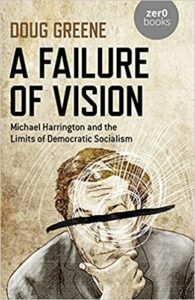Book Review: Two Failures of Vision

 Doug Greene, A Failure of Vision: Michael Harrington and the Limits of Democratic Socialism. Washington: 2021. 260 pages. Notes. Bibliography. No index.
Doug Greene, A Failure of Vision: Michael Harrington and the Limits of Democratic Socialism. Washington: 2021. 260 pages. Notes. Bibliography. No index.
Doug Greene has written his critical political biography of Michael Harrington, in large part it seems because he wants to understand the life and the mind of the man who was the grandfather of the Democratic Socialists of America, the largest left organization in America today. After telling the story, Greene suggests that Harrington suffered a “failure of vision” that is practically genetic and inherent in the DNA of DSA. But, if Harrington’s and DSA’s vision isn’t 20/20, the author believes it can be corrected by taking some Trotskyist medication or wearing Trotskyist lenses.
Greene’s biography, which makes up the first 164 pages of the book, is a pleasure to read. The author, who has read virtually everything that Harrington wrote in his long, productive, political life, recounts Harrington’s trajectory from his days as a young Catholic social activist, through his years in the Socialist Party, to his founding of DSA. Greene explains quite clearly and succinctly Harrington’s political ideas–most important his strategy of “realignment.” Greene writes about Harrington with some sympathy even though he disagrees with him and pauses occasionally to criticize him from the left, criticisms of Harrington’s pragmatic compromises with the labor bureaucracy and the Democratic Party with which I largely agree. While we have other accounts of Harrington’s political life, his own memoir The Long Distance Runner: An Autobiography and Maurice Isserman’s lengthy, thorough biography The Other American: The Life of Michael Harrington, still, if someone new to left politics asked me what to read about Harrington, I would suggest Green’s book–or at least those first 164 pages–despite my reservations.
Without recapitulating Green’s story of Harrington’s life, let me just point out what the author correctly identifies as the key turning points. An Irish American raised in the Roman Catholic Church, after leaving college the idealistic young Harrington joined the Catholic Worker movement founded and led by Dorothy Day, but after a couple of years left in search of a more satisfying political expression of his ideals. Harrington joined the Independent Socialist League (ISL), an organization led by Max Shachtman. that had come out of the Trotskyist left. Shachtman, a brilliant thinker, writer and speaker, made two significant contributions to Harrington’s intellectual and political life, one the theory of “bureaucratic collectivism” and the other the concept of “realignment” of the Democratic Party.
Shachtman first developed his theory of bureaucratic collectivism in the late 1930s. He criticized Trotsky’s continued support for the Soviet Union as a “a degenerated workers’ state,” that is, a state with a planned economy and nationalized property–both characteristic of socialism–but controlled by a reactionary “bureaucratic caste.” Shachtman differed. After the Hitler-Stalin non-aggression pact and the Nazi and Soviet invasion and division of Poland, followed by the Soviet war on Finland, Shachtman believed that one could no longer defend the Soviet Union. He believed that, under Stalin, the Communist Party and Soviet state bureaucracy had evolved into a new ruling class, neither capitalist nor socialist–and hostile to both–that oppressed and exploited the peasants and workers. The “bureaucratic collectivist” states, where the ruling party in effect owned and controlled the economy, Shachtman argued, had also become imperialist, as demonstrated by its aggression against Poland and Finland. Against both the capitalist and bureaucratic collectivist states and their economic systems, Shachtman argued that socialists should organize the “third camp,” made up of the world’s workers, peasants, and other oppressed groups under both capitalism and bureaucratic collectivism.
By the late 1950s and the early 1960s, Shachtman gradually broke with the genuine third camp position and inclined toward support of democratic capitalist states. Harrington, who was in that period Shachtman’s lieutenant, accompanied his mentor as during the Cold War era they drifted from a genuine third camp position to what became a qualified support for the West against the East.
In 1958, Shachtman took his Independent Socialist League into the Socialist Party where he now moved more rapidly to the right. In this period, Shachtman provided Harrington with another theory called “realignment,” specifically the realignment of the Democratic Party. Historically, the Trotskyists had stood for independent political action, that is, the building of either a socialist party or a labor party, But Shachtman and his protege Harrington, impressed by the Black movement, now called for “realignment,” that is the view that leftists could work with the labor unions and the civil rights movement to transform the Democratic Party, driving out the Southern racists and other conservatives. To carry out this task, the left had to join and work in the Democratic Party to advance those organizations and candidates who shared that strategic goal.
When he first developed this theory, Shachtman saw the former socialist Walter Reuther and other leaders of the United Auto Workers union as the key to realigning the Democrats, but as time went on Shachtman came to support George Meany, the head of the AFL-CIO who had come out of the racist building trades unions and who supported the U.S. war in Vietnam. Their commitment to the Democratic Party as the vehicle of change in 1964 led both Shachtman and Harrington and their comrade civil rights leader Bayard Rustin, to resist the demands of the Mississippi Freedom Democratic Party, the political expression of the civil rights movement, to seat their full delegation rather than the racist white delegation. They supported a so-called compromise that would have given most seats to the racists and just two to the MFDP.
It was the Vietnam War eventually drove a wedge between Shachtman and Harrington. The former supported the U.S. war against Vietnam and aligned with the pro-war Meaney and Democratic presidential candidate Senator Henry Martin “Scoop” Jackson, an anti-Communist hawk. Harrington, though he disliked the radicals in the anti-war movement and particularly those who carried Viet Cong flags and chanted, “Ho, Ho, Ho Chi Minh, Vietnam is going to win,” now broke with Shachtman and called for the United States to withdraw from Vietnam. Ultimately in the Democratic Party primaries, when Jackson was eliminated, Shachtman backed Hubert Humphrey while Harrington supported George McGovern. After Shachtman died in 1972, Harrington went on to found the Democratic Socialists of America, still committed to realignment of the Democratic Party; and DSA then joined the Socialist International, the organizing center of social democracy worldwide.
Having told the story of Michael Harrington’s intellectual and political evolution, and offered his criticisms from the left, one might think that Doug Greene’s job was done. But the author now adds an Appendix titled “The Meaning of Democratic Marxism” in which he argues that Harrington was not a Marxist at all, that he did not believe in historical materialism, that he rejected the Marxist and Leninist conception of revolution, that he identified with the Communist Party in the Popular Front period, and that he didn’t really understand or champion the anti-colonial struggles of the Third World. Greene says Harrington’s failure to grasp Third World struggles was because he failed to apply Trotsky’s theory of permanent revolution which Greene writes, mistakenly, “explains how revolutions were possible not only in Russia, but also in China, Cuba, Vietnam and elsewhere.” At this point, Greene launches into an attack on the theory of bureaucratic collectivism, which he clearly sees as Harrington’s original sin, offering in its stead Trotsky’s theory of the “degenerated workers state.” That is, Greene turns out to be an orthodox Trotskyist.
Coming to this point, I was shocked, since throughout the book Greene had approvingly cited people like Charlie Post and Kim Moody, who like me, come out of the third camp and hold the bureaucratic collectivist view. Greene, who showed excellent judgment throughout the biographical section of the book makes some odd and unsubstantiated claims in the appendix. He writes that the theory is “completely arbitrary and unable to understand the internal contradiction of the USSR and similar states.” Yet, as perhaps he knows, there are quite substantial, worked out theories—by Shachtman, Anton Ciliga, Yvan Craipeau, David Rousset, Jacek Kuron and Karol Modzelewksi, and several others—that analyze the political economy of the bureaucratic collectivist states. Greene cannot so blithely dismiss the bureaucratic collectivist theory; if he wants to take it on, he has to do so more seriously.
“Lastly,” Greene writes, “bureaucratic collectivism is based on a profound historical pessimism about the prospects of socialism.” Yet Post and Moody and others whom Greene clearly admires have not given up the fight for socialism in which we have been engaged for decades. The real pessimist is Greene who presents us with the orthodox Trotskyist theory that defends the Stalinists’ Communist states as some sort of “degenerated” ad “deformed” workers states. Greene is unable to bring to bear a socialist critique of those exploitative, oppressive, and imperialist states. Only a pessimist could be satisfied with such a theory and such “workers’ states.”
Greene also gets Harrington’s “failure of vision” wrong; it was not the theory of bureaucratic collectivism that led Shachtman and Harrington to turn to the right, it was their abandonment of a genuine revolutionary third camp position opposed to both capitalism and bureaucratic collectivism that turned them into social democrats. They became loyal activists in the capitalist Democratic Party, supporters of the capitalist system, and Shachtman also supported the Vietnam War while Harrington took too long to come to oppose it.
So, there are two failures of vision here. Harrington’s and Greene’s.